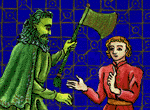


With boast and with bravery builds he that city
And names it with his own name, that it now bears.
Ticius to Tuscany, and towers raises,
Langobard in Lombardy lays out homes,
And far over the French Sea, Felix Brutus
On many broad hills and high Britain he sets, most fair. (Norton 202)
In tale of derring-do,
And linked in measures meetly
By letters tried and true. (Norton 203)

King noblest famed of will;
You would now go far to find
So hardy a host on hill. (Norton 203)
